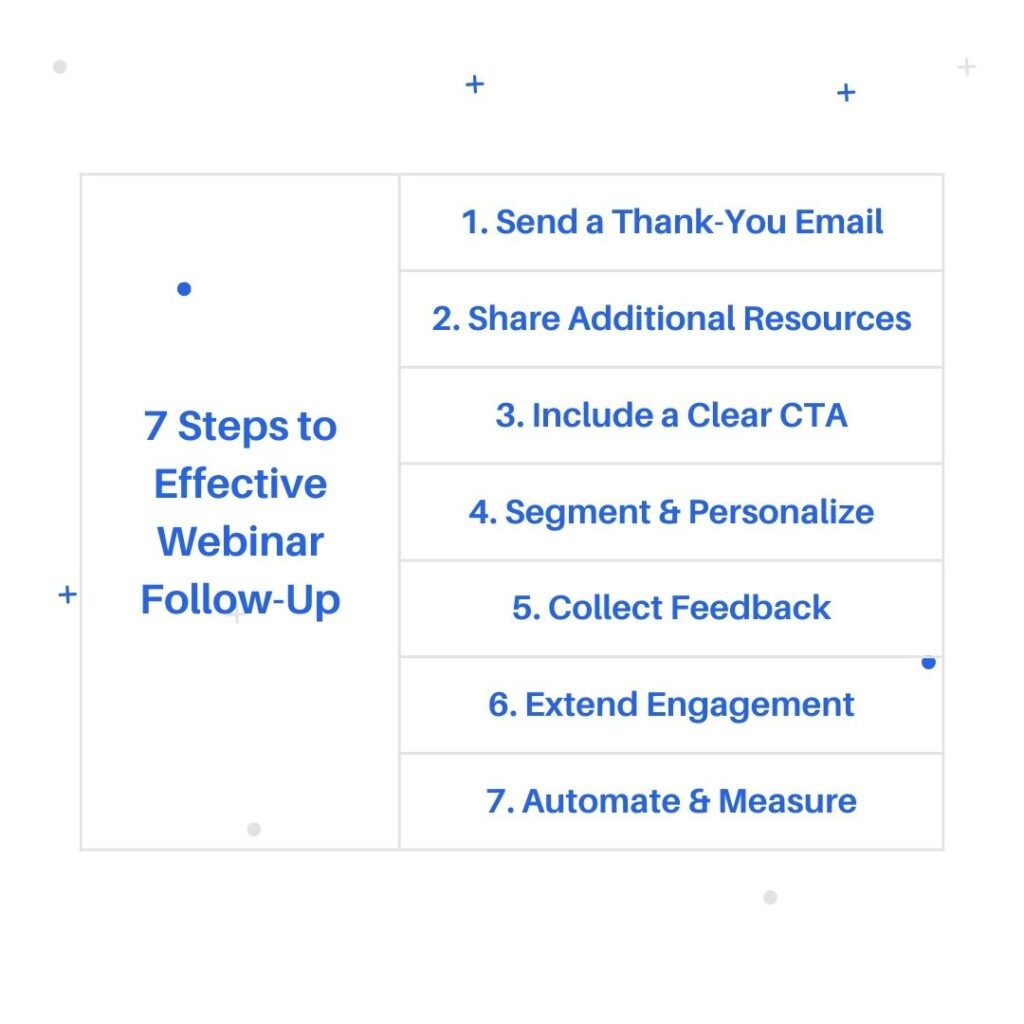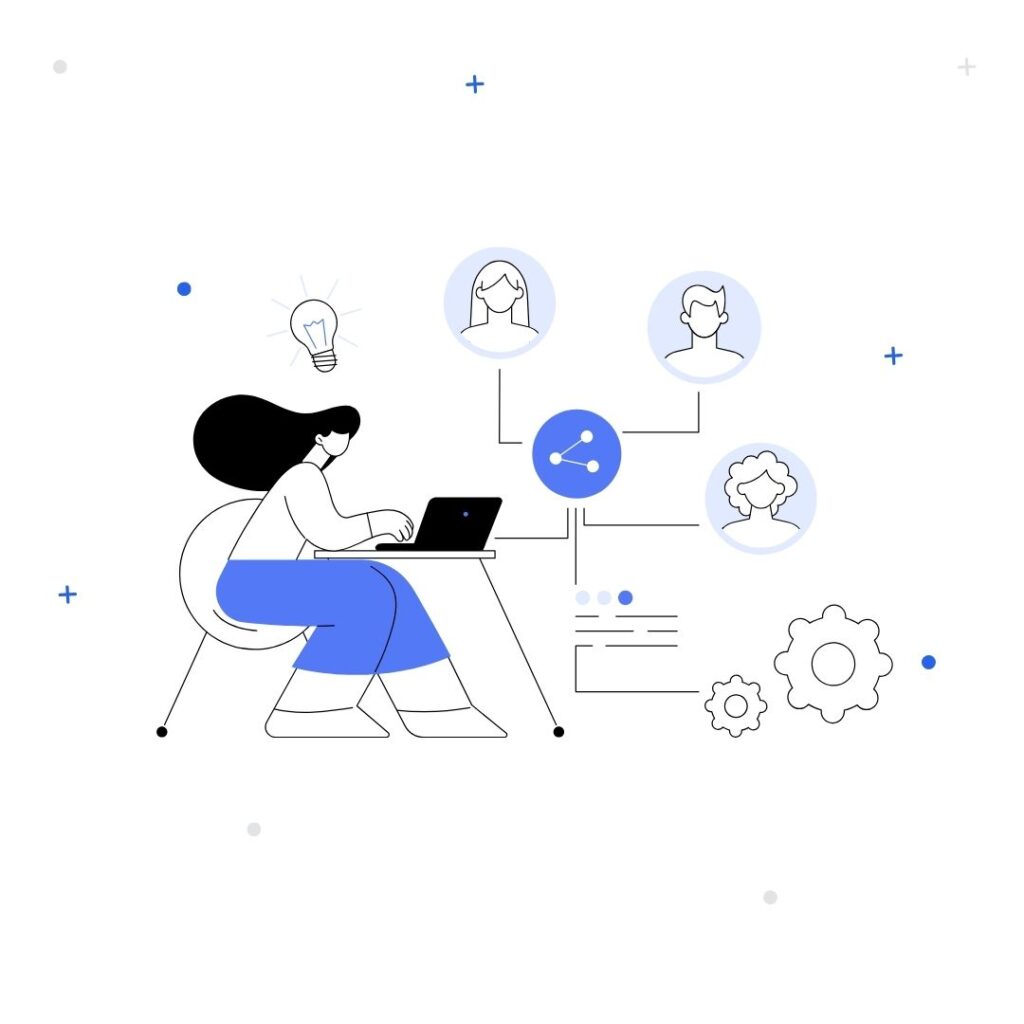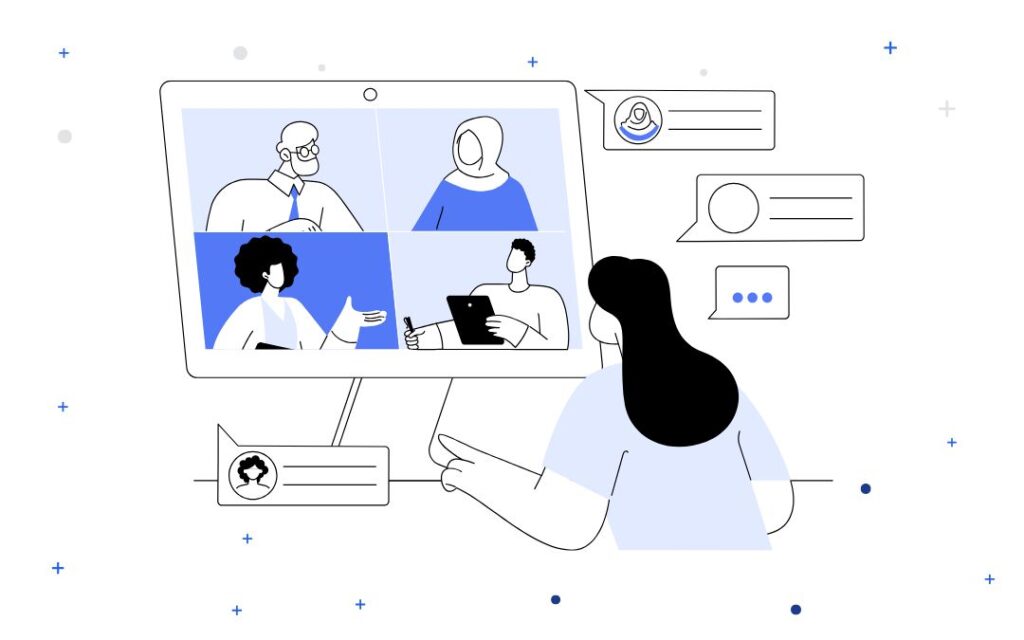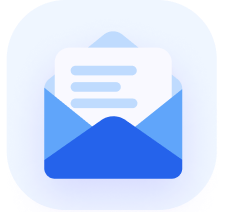Hosting a webinar is just the beginning. If you want to turn attendees into leads—and leads into customers—your follow-up strategy matters just as much as the live event itself.
Done right, your post-webinar follow-up becomes a conversion engine. It keeps the conversation going, adds more value, and gently nudges your audience toward action—without sounding like a pushy sales bot.
Let’s walk through how to make your follow-up feel like a natural next step, not a forgotten afterthought.
Take the manual work out of follow-up.
AEvent’s automation tools handle post-webinar emails, segmentation, and lead nurturing—so you can focus on conversions, not copy-pasting links.
Book a demo and see how seamless follow-up can be.
7 Steps to Effective Webinar Follow-Up
Your follow-up doesn’t need to be complicated—but it does need to be strategic. Taking a few intentional steps after your webinar ends can keep your audience engaged, build stronger relationships, and guide attendees toward meaningful next actions.
Here’s how to do it right, one step at a time.

1. Send a Timely Thank-You Email
Key Takeaway:
Send your thank-you email within 24 hours while your webinar is still fresh in attendees’ minds—include a replay link, key takeaways, and a personal touch.
The sooner you follow up, the better. Ideally, your thank-you email should land in attendees’ inboxes within 24 hours of the webinar—while the content is still fresh and the engagement is high. Wait too long, and you risk becoming just another forgotten tab in their browser history.
Your thank-you message doesn’t need to be long, but it should check a few key boxes:
- Start with a genuine note of appreciation for their time.
- Include a quick recap of the main takeaways to reinforce the value.
- Share a direct link to the webinar replay, presentation slides, or any promised resources.
If you’re looking for guidance on what to say and how to structure your messages, take a look at these tips for writing effective webinar email sequences. A strong follow-up starts with the right words.
And don’t forget personalization. Use your attendee’s name, and if possible, reference something specific—like a question they asked or a poll they participated in. It’s a small touch that makes a big impact.
Make sure your replay link stands out—bold it, button it, and keep it front and center so attendees don’t have to go searching.
2. Share Additional Resources
Key Takeaway:
Following up with valuable resources—like slides, bonus guides, or related articles—keeps the conversation going and positions you as a trusted expert.
Your attendees showed up because they were interested in your topic. So why stop at just a replay? Sharing curated resources after your webinar gives your audience more value, builds trust, and subtly guides them further down your funnel.
Include materials that complement what they just learned:
- A downloadable slide deck for easy reference
- A bonus worksheet or checklist
- Links to relevant blog posts, case studies, or product guides
- An industry report that reinforces your message
And don’t forget the webinar recording. It’s a second chance to engage attendees who want a refresher—or a way to reach registrants who couldn’t make it live. A clean, accessible replay link is your follow-up MVP.
Offering helpful content instead of a hard pitch establishes you as a go-to resource, and makes it more likely that your audience will stick around for what comes next.
3. Include a Clear Call-to-Action
Key Takeaway:
Every follow-up should guide attendees to one clear next step—whether it’s booking a demo, downloading a resource, or signing up for your next event.
The most effective follow-ups don’t just say “thanks”—they point the way forward. That could mean inviting attendees to:
- Schedule a one-on-one consultation
- Register for a related upcoming webinar
- Download an in-depth guide or case study
- Start a free trial or product demo
The key is to choose one primary action and make it crystal clear. Your CTA should feel like a natural continuation of the webinar—not an unexpected sales pitch.
If you’re wondering what kind of results to aim for, check out these industry insights on webinar conversion benchmarks. Knowing what’s typical—and what’s excellent—can help you shape your goals and calls to action accordingly.
Make it easy to act. Use bold buttons, short forms, and benefit-driven copy. For example:
“Want to see this in action? Book a live demo with our team.”
“Download the guide to put these strategies into practice today.”
Remember: if you don’t tell your audience what to do next, they’ll do nothing.
4. Segment and Personalize Your Follow-Up

Key Takeaway:
Tailoring your follow-up based on attendee behavior boosts relevance—and relevance drives results.
Not all webinar attendees are in the same place. Some asked questions, some stayed until the end, and some may have just popped in and bounced. Treating them all the same in your follow-up? That’s a missed opportunity.
Start by segmenting your audience based on their engagement level:
- Highly engaged: stayed for most or all of the session, asked questions, responded to polls
- Partially engaged: attended but didn’t interact
- No-shows or registrants who missed it
Now tailor your messaging accordingly. Highly engaged leads might be ready for a sales conversation. Others may need more education or nurturing content. Use insights from registration forms, polls, chat interactions, and attendance data to shape your approach.
If you’re managing multiple webinars or a recurring series, consider how automation for recurring webinars can simplify personalized follow-up at scale. With the right system in place, you can deliver targeted messaging without manually sorting through every attendee list.
The more relevant your message feels, the more likely it is to get noticed—and acted on.
➔Want to take it a step further? Personalize your emails using names, company info, or webinar-specific touchpoints (“We loved your question about X…”). These small details go a long way in building trust and rapport.
5. Collect Feedback
Key Takeaway:
Asking for feedback not only helps you improve—it shows attendees that their opinions matter.
Your webinar might be over, but your learning isn’t. Post-webinar feedback is one of the easiest ways to understand what worked, what didn’t, and what your audience wants more of.
Include a short survey in your follow-up email—ideally, no more than 3–5 questions. Ask about the content quality, the presenter, the platform experience, and whether the session met their expectations.
Bonus points if you leave room for open-ended responses. Sometimes the most valuable insights come from unscripted comments.
Want to increase your response rate? Offer a small incentive: a discount code, exclusive content, or a gift card raffle. A little motivation can go a long way.
Beyond improvement, feedback also builds connection. It sends a clear message: we’re listening. And that kind of attentiveness strengthens your relationship with your audience long after the webinar ends.
6. Extend Engagement Beyond Email
Key Takeaway:
Don’t let your webinar live and die in the inbox—repurpose it across channels to keep the momentum going.
Your follow-up emails are just the start. To truly maximize your webinar’s value, extend its reach through your other marketing channels.
Start by sharing key moments on social media. Pull out short video clips, impactful quotes, or interesting poll results and turn them into scroll-stopping posts. Platforms like LinkedIn and Instagram are perfect for sparking new conversations and drawing in fresh eyes.
Then look at how you can repurpose the content. Turn your main points into a blog post, break insights into an email mini-series, or create an infographic that summarizes the session visually. You’ve already done the hard work—now it’s about squeezing every drop of value from it.
And don’t forget internal uses too. A great webinar can become sales enablement material, onboarding content, or training for new team members.
The more places your content lives, the longer it keeps working for you.
7. Automate and Measure Your Follow-Ups
Key Takeaway:
Automation saves time, and tracking results helps you do it better every time.
Following up manually might work if you’re hosting a one-off webinar—but for repeatable success, automation is essential. With the right tools, you can deliver timely, relevant messages without spending hours in your inbox.
Set up a sequence of 3–5 emails that nurture your audience over time:
- Day 1: Thank-you email with replay and key takeaways
- Day 3: Bonus resources or a helpful guide
- Day 7: Focused CTA—book a call, download a lead magnet, or take the next step
- Day 14+: Case study or reminder for your next webinar
As your sequence runs, keep tabs on the data. Monitor open rates, clicks, and conversions to refine your messaging. If you’re using a platform like AEvent, you can automate the entire process—from personalized follow-ups to real-time engagement tracking—while syncing everything with your CRM.
That means less manual work for you—and a better, more consistent experience for your audience.
Example Follow-Up Email Structure
Your follow-up email should be short, clear, and focused on value—make it easy for attendees to re-engage and take the next step.
Here’s a structure you can use (or adapt) for your thank-you email within 24 hours of the webinar:

Maximize Your Webinar’s Impact with Smart Follow-Up
Your webinar might be over, but the opportunity to build trust, add value, and drive conversions is just getting started.
With a thoughtful follow-up strategy—one that includes timely thank-yous, helpful resources, clear CTAs, and ongoing engagement—you’re not just staying in touch. You’re guiding your audience toward the next step in their journey with you.
And when you automate that process with a platform like AEvent, it becomes effortless. From sending personalized follow-ups to tracking behavior and syncing with your CRM, AEvent helps you keep the momentum going, without the manual heavy lifting.
So if you’re ready to turn more attendees into customers, the follow-up is where it happens.
Book a demo today and see how we can help you scale your webinar results with less effort and more impact.






